Christ Episcopal Church: Church-on-the-Hill
Church-on-the-Hill
Winnetka, IL
Images
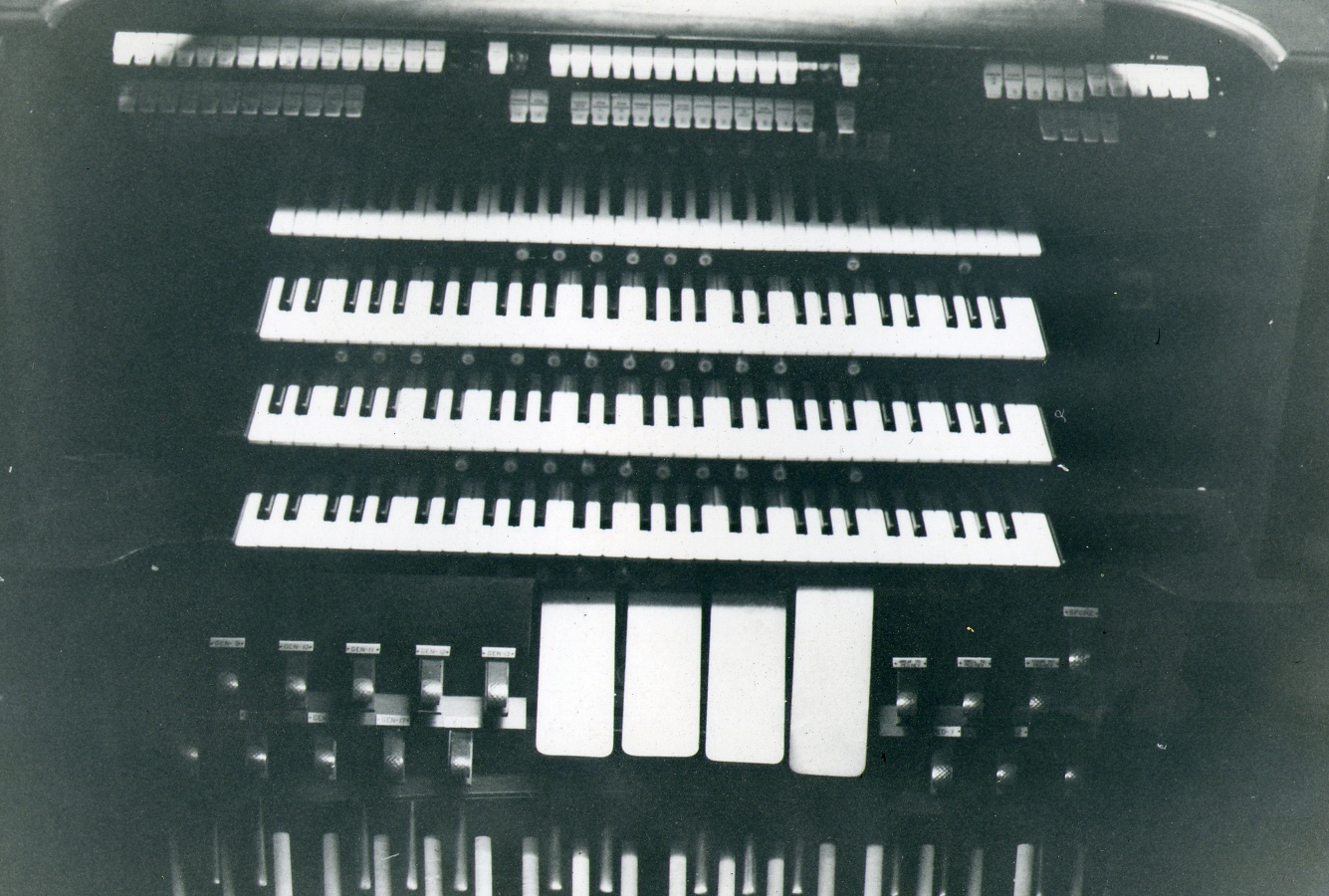 Unknown - Console, Autumn 1984. (Photograph by Rick Erickson/Database Manager)
Unknown - Console, Autumn 1984. (Photograph by Rick Erickson/Database Manager)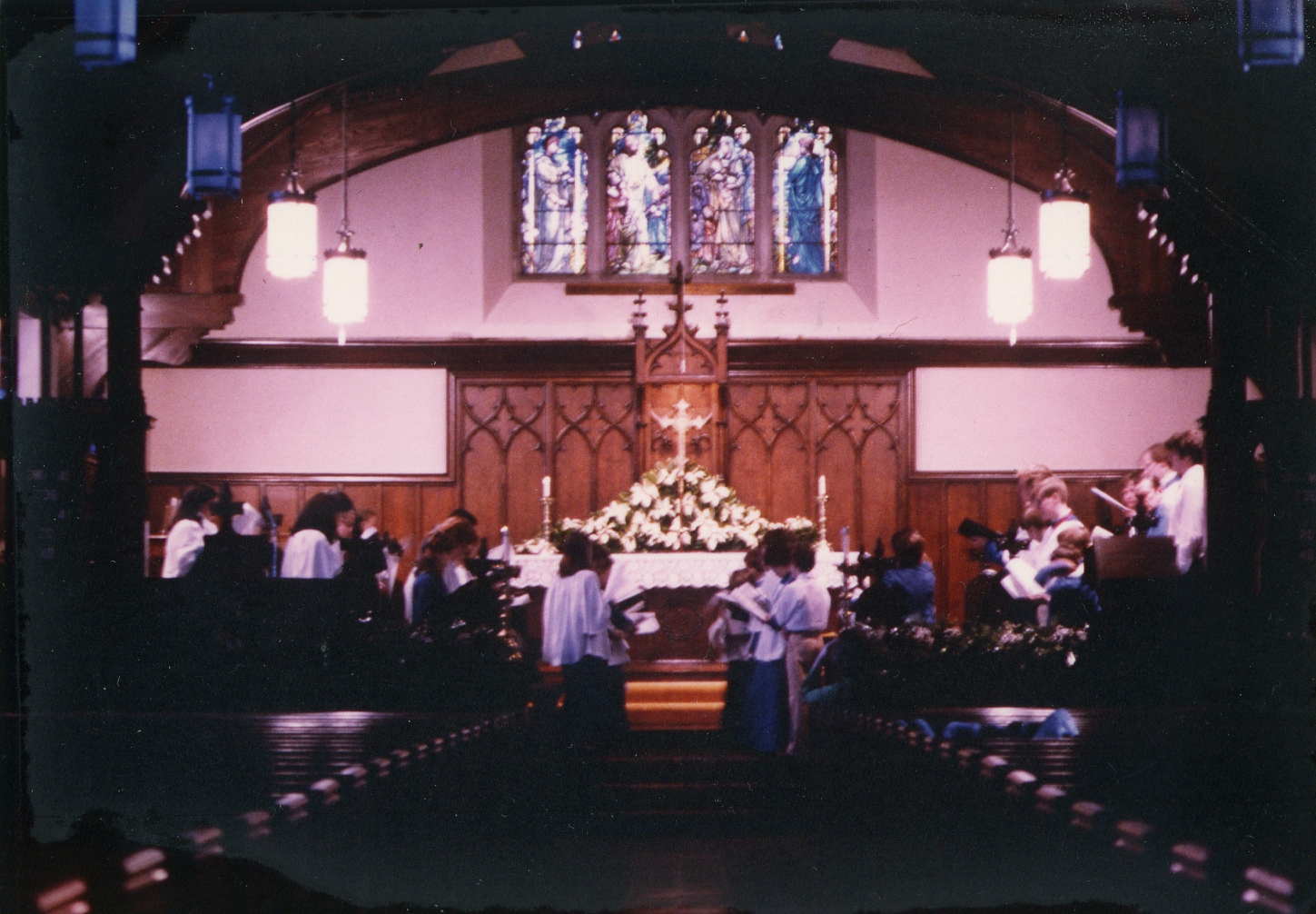 1982-04-11 - Easter Sunday chancel with Tiffany window above the high altar (Photograph by Rick Erickson/Database Manager)
1982-04-11 - Easter Sunday chancel with Tiffany window above the high altar (Photograph by Rick Erickson/Database Manager)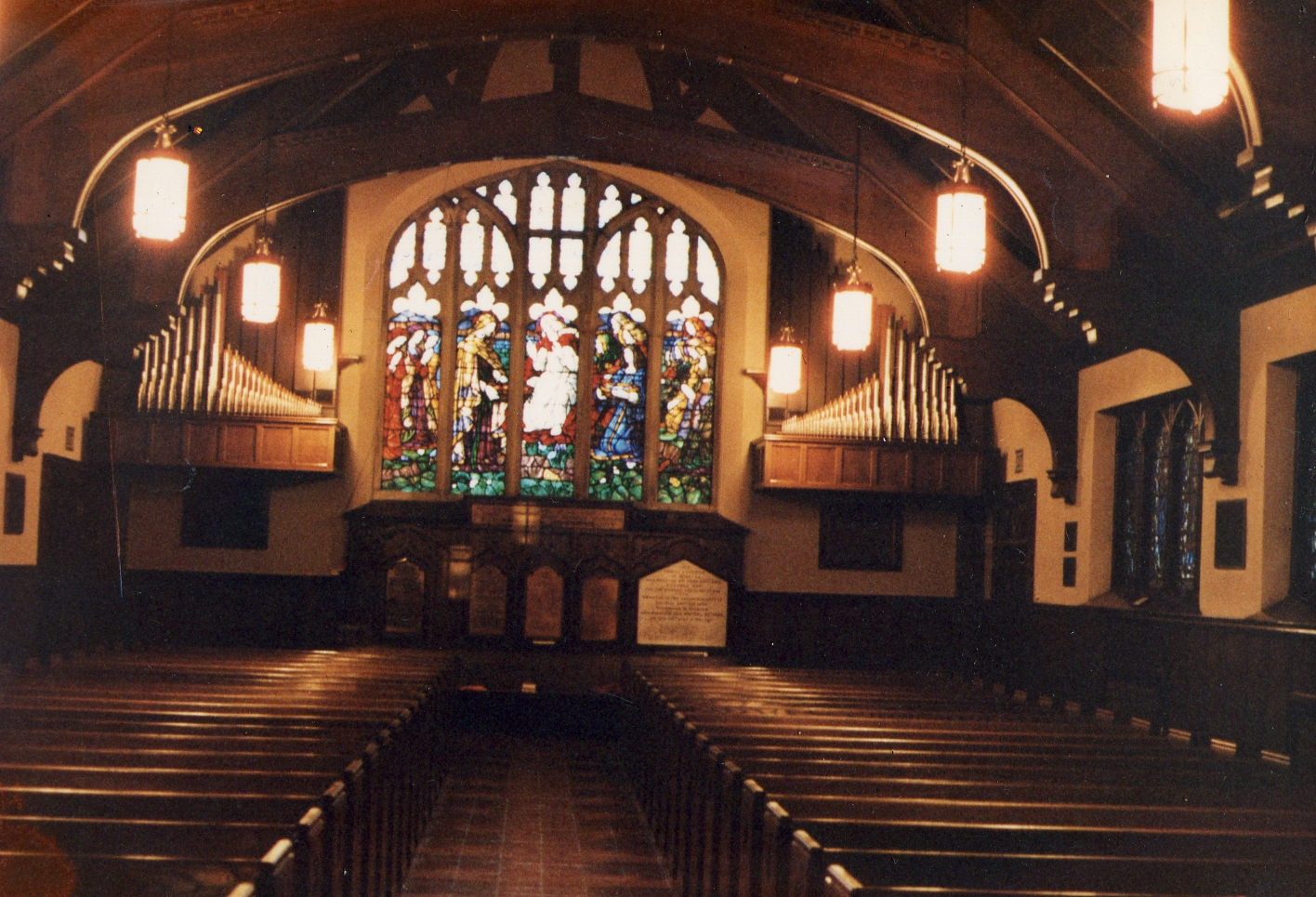 Unknown - East end of nave with Antiphonal division flanking window, Autumn 1984. (Photograph by Rick Erickson/Database Manager)
Unknown - East end of nave with Antiphonal division flanking window, Autumn 1984. (Photograph by Rick Erickson/Database Manager)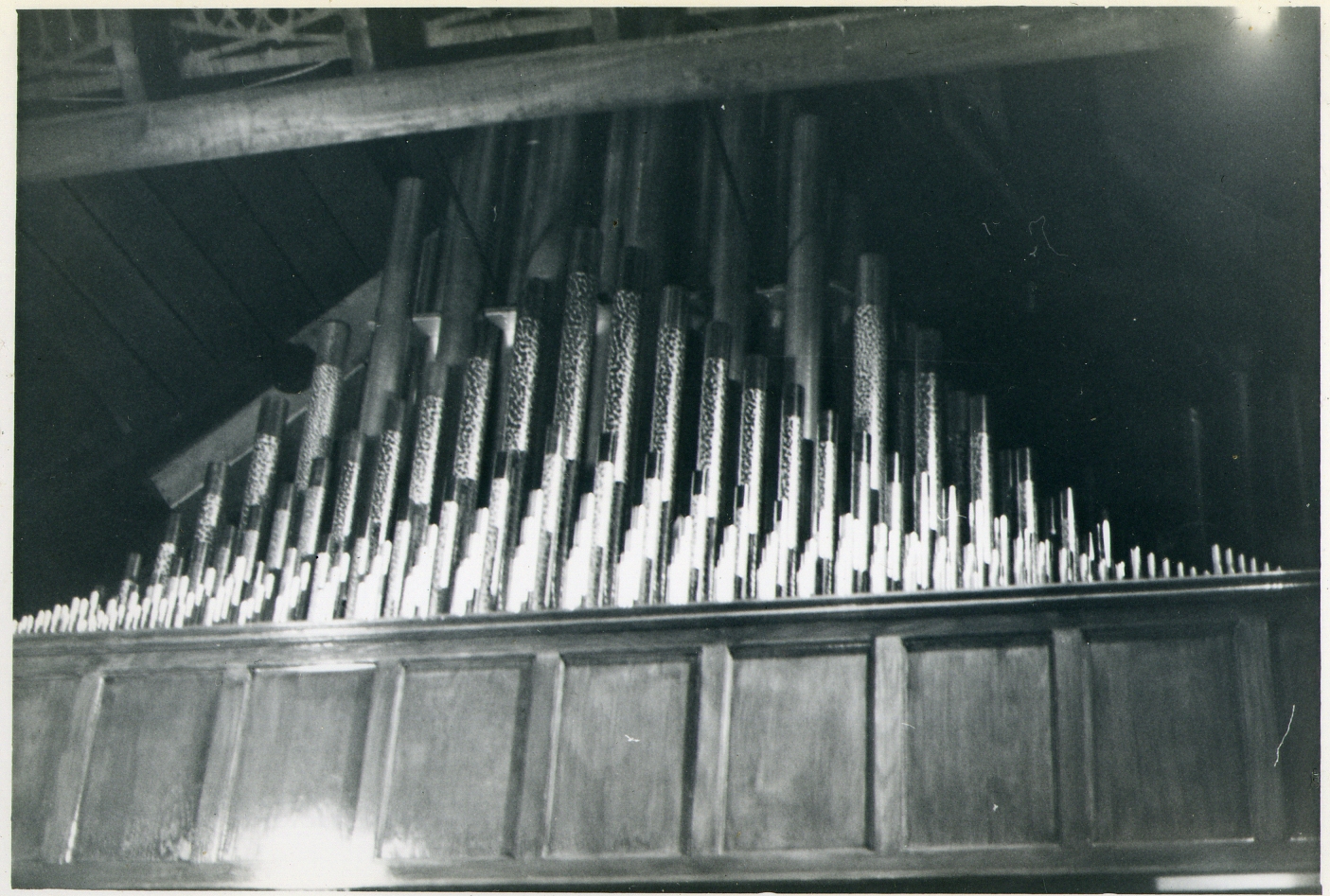 Unknown - Exposed Great pipework, Autumn 1984. (Photograph by Rick Erickson/Database Manager)
Unknown - Exposed Great pipework, Autumn 1984. (Photograph by Rick Erickson/Database Manager)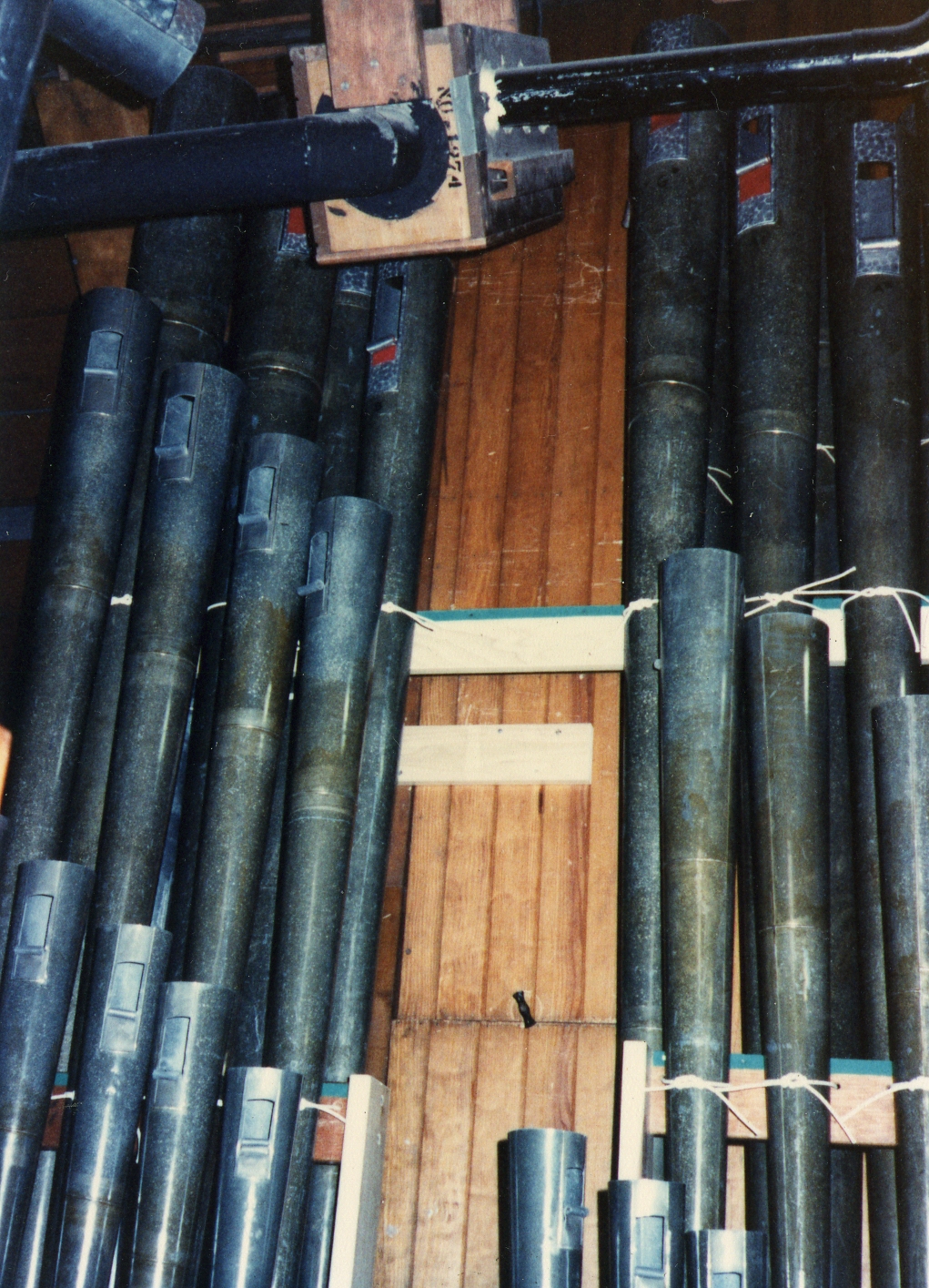 Unknown - Pedal 16'Trombone with winding for Pedal 16' Open Wood above, Autumn 1984. (Photograph by Rick Erickson/Database Manager)
Unknown - Pedal 16'Trombone with winding for Pedal 16' Open Wood above, Autumn 1984. (Photograph by Rick Erickson/Database Manager)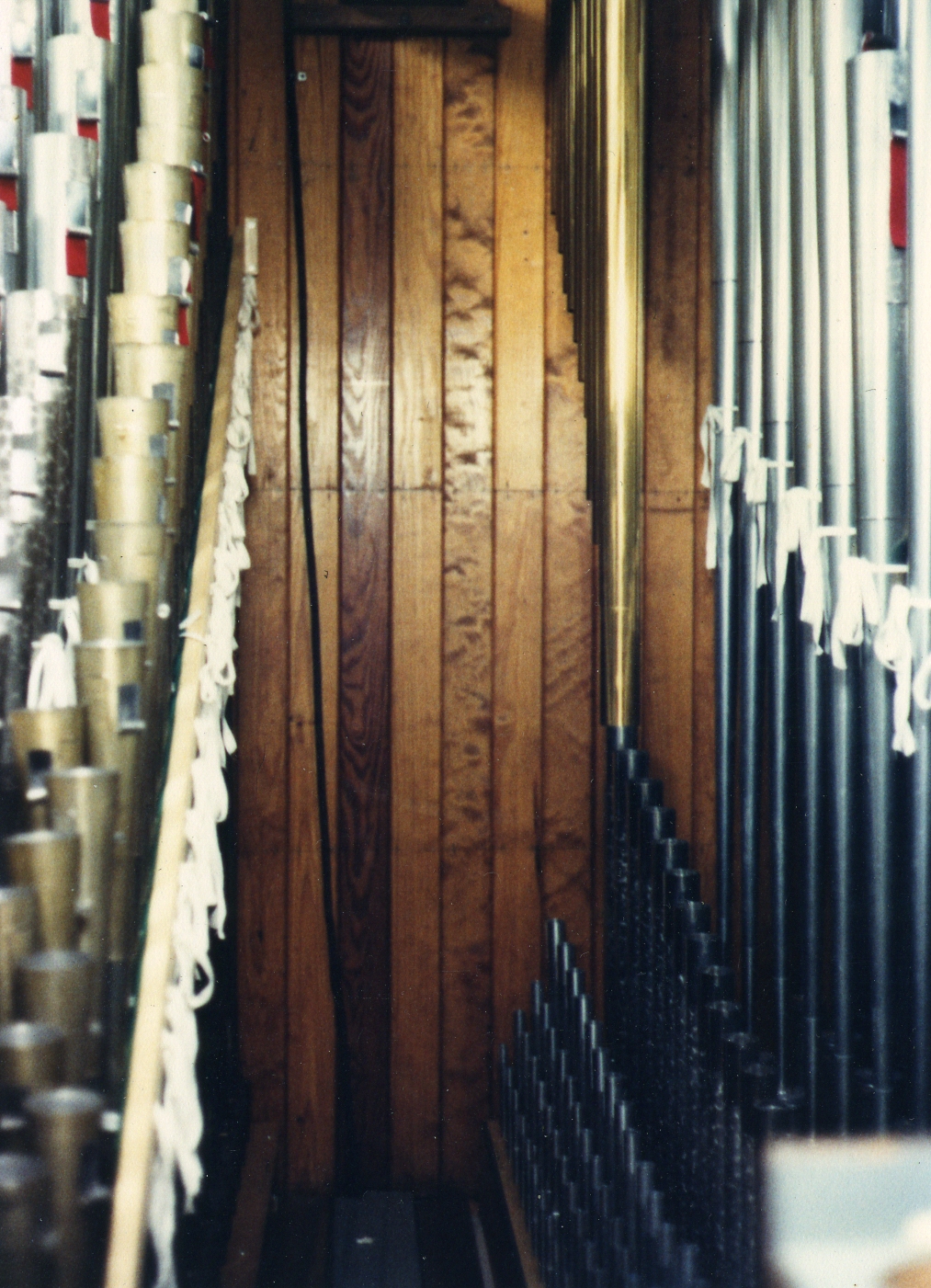 Unknown - Swell pipework, Autumn 1984. (Photograph by Rick Erickson/Database Manager)
Unknown - Swell pipework, Autumn 1984. (Photograph by Rick Erickson/Database Manager)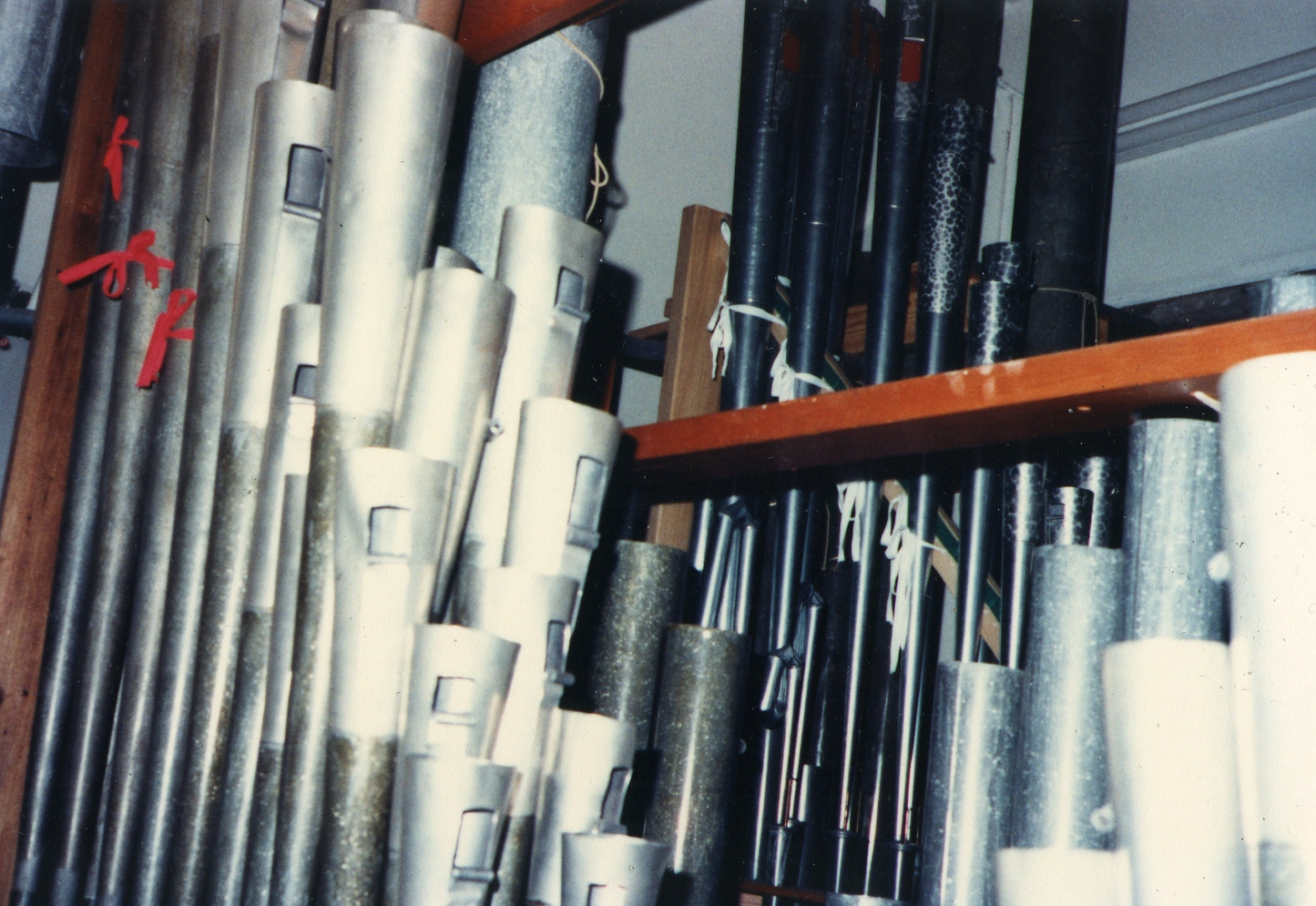 Unknown - Solo reeds, Autumn 1984. (Photograph by Rick Erickson/Database Manager)
Unknown - Solo reeds, Autumn 1984. (Photograph by Rick Erickson/Database Manager)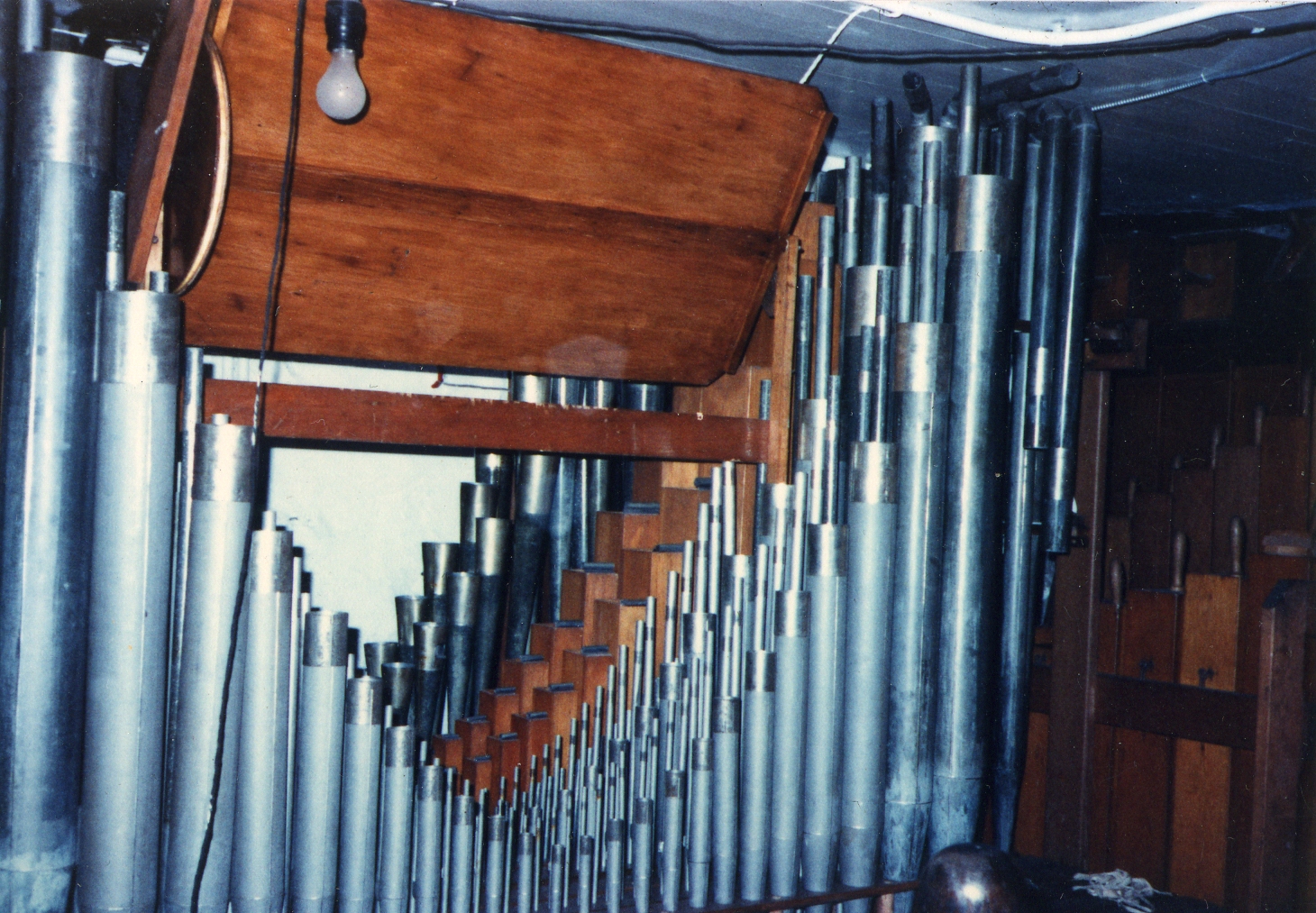 Unknown - Echo pipework under fan tremulant, Autumn 1984. (Photograph by Rick Erickson/Database Manager)
Unknown - Echo pipework under fan tremulant, Autumn 1984. (Photograph by Rick Erickson/Database Manager)
Consoles
Main
- Organ type: Traditional Without Cover
- Console position: Console in Fixed Position, Left
- 4 manuals
- 68 stops
- 8 divisions
- Key action Type: Electrical
- Stop action Type: Electrical
- Stop layout Type: Stop Keys Above Top Manual
- Manual compass: 61 notes
- Pedal compass: 32 notes
- Pedal Type: Concave Radiating (Meeting AGO Standards)
- Expression Type: Balanced Expression Shoes/Pedals (Meeting AGO Standards)
- Combination action: 'Hold and Set' Pneumatic/Mechanical
- Has combination thumb pistons
- Has coupler toe pistons
- Has tutti thumb pistons
- Has tutti toe pistons
Notes
2011-01-19 - Identified through on-line information from Rick Erickson. -Database Manager
2011-01-29 - Updated through on-line information from Rick Erickson. -Database Manager
Stoplist
Stoplist taken from console, Easter 1983, and from the factory specification Source: Source not recorded Date not recorded
Winnetka, Illinois
Christ Episcopal Church
(Church-on-the-Hill)
Austin, Opus 1274, 1924
Rebuilt by Austin, 1983
Great Organ, unenclosed, all new pipework on new chest above choir stalls,
Manual II, 3.5 inch windpressure
16’ Double Open Diapason, 12 from Pedal 16’ Open Metal,
49 ext of Open Diap. #2
8’ Open Diapason #1, Scale 43, ¼ mouth, 17R
8’ Open Diapason #2, Scale 45, ¼ mouth, 17R
8’ Harmonic Flute, Scale 50, 2/9 mouth, 17R
4’ Octave, Scale 46 (58), ¼ mouth, 17R
2’ Super Octave, Scale 47 (71), ¼ mouth, 17R
IV Mixture, Unisons Scale 47, ¼ mouth, 17R, quints Scale 49, 2/9m, 17R
(19,22,26,29 for 13 notes, 15,19,22,26 for 12 notes, 12,15,19,22 for
12 notes, 8,12,15,19 for 12 notes, 1,8,12,15 for 12 notes)
8’ Trumpet, CC = 3 3/8”, Harmonic from #43, 54 reeds,
German medium shallots
Great to Great 16, Unison Off, Great to Great 4
Transept on Great
Swell to Great 16, Swell to Great 8, Swell to Great 4
Choir to Great 16, Choir to Great 8, Choir to Great 4
IV to Great 8, IV to Great 4
Transept Organ, unenclosed, in Transept chamber, Manual II,
5.25 inch windpressure
8’ Open Diapason, 1955
4’ Octave, 1955
III Mixture (15,19,22) ,1955
Choir Organ, expressive, Manual I, 6 inch windpressure
16’ Bourdon, 1924 Swell
8’ Open Diapason, 1983, Scale 47, 2/9 mouth, 17R
8’ Melodia, 1924 Choir, TC = 2 3/16 x 2 5/8” int.,
bottom octave is 1924 Swell 8’ Stopped Flute
8’ Unda Maris, 1924 Choir
4’ Principal, 1983, Scale 48 (60), 2/9 mouth, 17R
4’ Kopple Flute, 1955, revoiced
2’ Fifteenth, 1983, Scale 49 (73), 2/9 mouth, 17R
1 1/3’ Octave Quint, 1983, Scale 45 (76), ¼ mouth,18R, 2/3 taper
III Cymbal, 1983, (All Scale 52, ¼ mouth, 17R)
(29,33,36 18 notes, 26,29,33 12 notes, 22,26,,29 6 notes,
19,22,26 6 notes,15,19,22 6 notes, 12,15,19 6 notes, 8,12,15 7 notes)
8’ Clarinet, 1924, revoiced
Tremolo
8’ Festival Harmonic Trumpet (IV Solo)
Choir to Choir 16, Unison Off, Choir to Choir 4
Swell to Choir 16, Swell to Choir 8, Swell to Choir 4
IV to Choir 8
IV to Choir 4
Swell Organ, expressive, Manual III, 6 inch windpressure
8’ Open Diapason, 1983, Scale 46, ¼ mouth, 17R
8’ Chimney Flute, new, Scale 46 (58), ¼ mouth, 18R, with chimneys,
bottom octave is 1924 Choir 8’ Melodia stopped basses
8’ Salicional, new, Scale 50, 1/5 mouth, 17R
8’ Vox Angelica, new, Scale 50, 1/5 mouth, 17R
8’ Gemshorn, 1924 Great
4’ Principal, 1983, Scale 47 (59), 2/9 mouth, 17R
4’ Spire Flute, 1983, Scale 43 ( 55), ¼ mouth, 18R, 2/3 taper
2 2/3’ Nasard, 1983, Scale 43 (62), 2/9 mouth,18R
2’ Octavin, 1983, Scale 43 (67), ¼ mouth, 18R
1 3/5’ Tierce (TC), 1983, Scale 43 (83), 2/9 mouth,18R
IV Mixture, 1983, (Unisons Scale 48, ¼ mouth, 17R, Quints Scale 50,
2/9m, 17R)(22,26,29,33 13 notes, 19,22,26,29 12 notes, 15,19,22,26
12 notes,12,15,19,22 12 notes, 8,12,15,19 6 notes, 5-18,12,15 6 notes)
16’ Double Trumpet, 1983, CCC = 4 inch, half length, German medium shallots
CC = 3 inch, Harmonic from #55, 61 reeds, German med. shallots
8’ Cornopean, 1983, CC = 3.73 inch, Harmonic from #37, 54 reeds,
English shallots
8’ Oboe, 1924
8’ Vox Humana, 1924
4’ Clarion, 1955 Swell 8’ Trumpet revoiced
Tremolo
Swell to Swell 16, Unison Off, Swell to Swell 4
IV to Swell 8
Antiphonal Organ, unenclosed on 2 new chests divided either side of window,
Manual IV, 3.5 inch windpressure
8’ Stopped Diapason, 1983, (wood)
4’ Principal, 1983, Scale 47 (59), ¼ mouth, 17R
2’ Fifteenth, 1983, Scale 48 (72), ¼ mouth, 17R
III Mixture, 1983, (Unisons Scale 48, ¼ mouth, 17R, Quints 50, 2/9m, 17R)
(19,22,26 15 notes, 15,19,22 15 notes, 12,15,19 15 notes,
8,12,15 16 notes)
Antiphonal on IV
Echo Organ, expressive, located in tower, Manual IV, 6.5 inch windpressure
8’ Stentorphone, 1924
8’ Major Flute, 1924
8’ Viole Angelica II, 1924
4’ Fugara, 1924 Swell
8’ Tromba, 1924 Great
Tremolo
Solo Organ, on new chests in Transept chamber
8’ Festival Harmonic Trumpet, 1983, CC =4 inch, Harmonic from #37,
French shallots, 61 reeds, hooded resonators,
top 13 notes doubled with flutes Scale 44, ¼ mouth, 17R
8’ Tuba, CC = 5 inch , English shallots, second-hand Hall pipework
Chimes (25 notes, Deagan)
The following 5 speaking stops are only repared for,
the pipework in storage, 7 inch wind pressure:
8’ Open Diapason, 1924 Swell
8’ Dopple Flute, 1924 Great
8’ Gross Gamba, 1924 Solo/Echo
8’ Gamba Celeste, 1924 Great
8’ French Horn, 1924 Solo/Echo
IV to IV 4
Great to IV 8
Swell to IV 8
Choir to IV 8
Pedal Organ, 6 inch windpressure
32’ Acoustic Bass, (low 12 acoustic, ext. 16’ Bourdon)
16’ Open Wood, 1924
16’ Open Metal, 1955
16’ Bourdon, 1924
16 ‘Second Bourdon , (Choir), 1924
8’ Octave, 1983, Scale 45, 2/9 mouth, 17R
8’ Bass Flute , (ext 16 Bourdon)
4’ Fifteenth, 1983, Scale 44 (56), ¼ mouth, 17R
III Mixture , 1983, (22,26,29, no breaks)
(Unisons Scale 46, ¼ mouth, 17R, Quint Scale 48, 2/9m, 17R)
16’ Trombone, 1924, revoiced
16’ Double Trumpet (Swell)
8’ Octave Trombone, (new pipework, ext. of 16 Trombone)
16’ Antiphonal Bourdon (ext. Ant. 8 St. Diap.), CCC = 6 .5 X 9.25 inch
16’ Echo Bourdon, 1924
Great to Pedal 8
Swell to Pedal 8, Swell to Pedal 4
Choir to Pedal 8, Choir to Pedal 4
IV to Pedal 8
IV to Pedal 4
Pistons adjustable, visibly moving stops
8 General thumb pistons placed above the top manual,
and 6 further thumb pistons placed in key slips,
6 of which are duplicated by toe pistons,
and 4 further general toe pistons (18 in all)
5 Thumb pistons to Choir
8 Thumb pistons each to Great and Swell
6 Thumb pistons to IV
3 Toe pistons to Pedal
Rev. Thumb and toe pistons: Great to Pedal, Swell to Pedal, Choir to Pedal
Sforz. Rev. thumb and toe pistons
Austin patent canceller bars placed over each group of stops
General cancel thumb piston
Pedal on any manual pistons adjustor stop key
Balanced expression pedals: Choir, Swell, and Echo
All Swells to Swell reversible thumb piston with light indicator
Balanced Crescendo pedal
Blowing by Spencer Orgoblo and by British Organ Blowing Co.
The rebuilt organ used for the first time on Easter Day 1983. With supplemental contracts for oak cases and
associated building work the cost, came to $250,000. The tonal scheme was drawn up by Rick L. R. Erickson,
Christ Church organist and choirmaster from 1980 to 1983, in cooperation
with David A. J. Broome, vice
president and tonal director at Austin. The installation was done by Hugh H. Sears, and the pipework was tonally
finished by Zoltan Zsitvay, both of Austin Organs. Since the basic siting
of the organ could not be changed
the old wind chests were reactioned, and the old reservoirs releathered. The Swell was relocated onto the old
Great and Choir windchests, in a position to better project the sound into the
room. The Choir was relocated
onto the old Swell windchest, but without the obstruction of a disused chimney. The entirely new Great was
canter-levered on a new exposed windchest in front of the organ chamber, above and behind the North choirstalls.
A new unenclosed windchest in the chamber accommodates new Pedal stops. Thus the chancel divisions form a
complete 3-manual instrument of 49 ranks for accompanying the choir and
playing service voluntaries,
effectively the “main organ”.
Without making these chancel divisions too loud and over powering the choir singers, the retained
secondary Transept division leads the congregation. The high-pressured reeds are also located in the transept
chamber, both with enough power individually or together to cut through or top “full organ”. Other 1924
pipework has been carefully stored to eventually create a complete Solo division.
At the rear of the Nave a chorus of four stops was constructed and hung on
the back wall on two new
windchests balanced on both sides of a large window. The retained 1924 stops in the Tower provide soft sounds
at that end of the building, and are used in some music of a mystical or nostalgic character, and
can thicken or colour the sound of the thinner scaled Antiphonal. Designed primarily to accompany
choirs and lead congregational service music, the rebuilt organ is at its best with the Anglican liturgy
and British repertoire whilst not obscuring its romantic American accent. Some of the discussed 1924 pipework
found its way to the Episcopal Church of the Epiphany, Chicago, where at least the 8' Choir Violin Diapason
and part of a 4’ have been reused. The old console was repositioned in the South choirstalls to allow the
organist to more easily conduct the choir, and was entirely rebuilt. The console controls particularly,
the combination pistons, are perhaps one of the last such instances of such a large Austin being controlled
without Solid State electronics.
As part of a reordering of the chancel in 1983 H. A. Howell Pipe Organs,
Inc., Sterling, Illinois, made
alterations to the organ. In particular the 1983 Great Organ was modified to become a Positiv Organ, and the
1955 Transept Organ was replaced with a new encased Great Organ of 10 stops.
[Received from Rick Erickson 2011-01-25.]
Related Pipe Organ Database Entries
Other Links
Regrettably, it is not possible to display the information about the sponsor of this pipeorgandatabase entry or if there is a sponsor. Please see About Sponsors on Pipe Organ Database.







